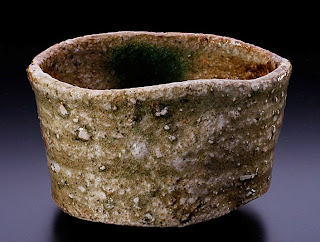A friend sent me this picture recently and at first
glance it looked like an antique Seto pot, turn of the century or a bit older,
until I really looked at it. Though I doubt I would have guessed who made it,
the brushwork was very familiar. What is
obviously based on old Momoyama style suibokuga, the decoration is an
abstracted landscape which speaks of far off places and a very tranquil and
calming atmosphere which the form echoes. I marvel at the abbreviated and
direct decoration, it speaks of nearly an infinite variety of landscapes and
places we all know and love. In its own way, it is any place we can imagine, painting a grand illusion in its brevity.
What ends up being a rather powerful and evocative brush stroke is an excuse to
get lost in a myriad of possibilities.
In truth this is not Seto-yaki, rather it is Iga
pottery, not the Iga that normally comes to mind, but rather the place it was
created and the potter, Banura Shiro, is every bit the Iga potter. Working in
styles influenced by much older pottery and the Rimpa tradition, Banura created
work that relies on common designs, motifs and decoration, but used in a potent
and original manner while making them best fit three dimensional forms, a skill
he excelled at. First dipped in a coat of white slip, the iron brushwork is
applied, over which an ash based translucent amber glaze is used and the
results are quite wonderful. It ends up being a rather earthy pot which exudes
charm and at the end of the day, this is one of the most antique modern pots I
have seen in some time and this but another skill of Banura Shiro.
"The closest way into the universe is through a
forest wilderness." John Muir












